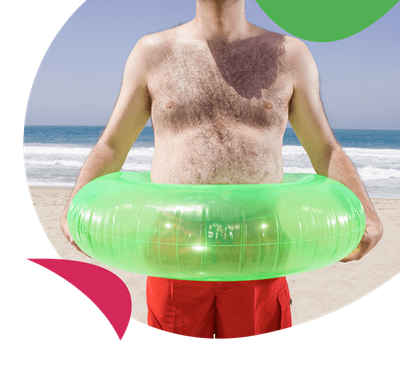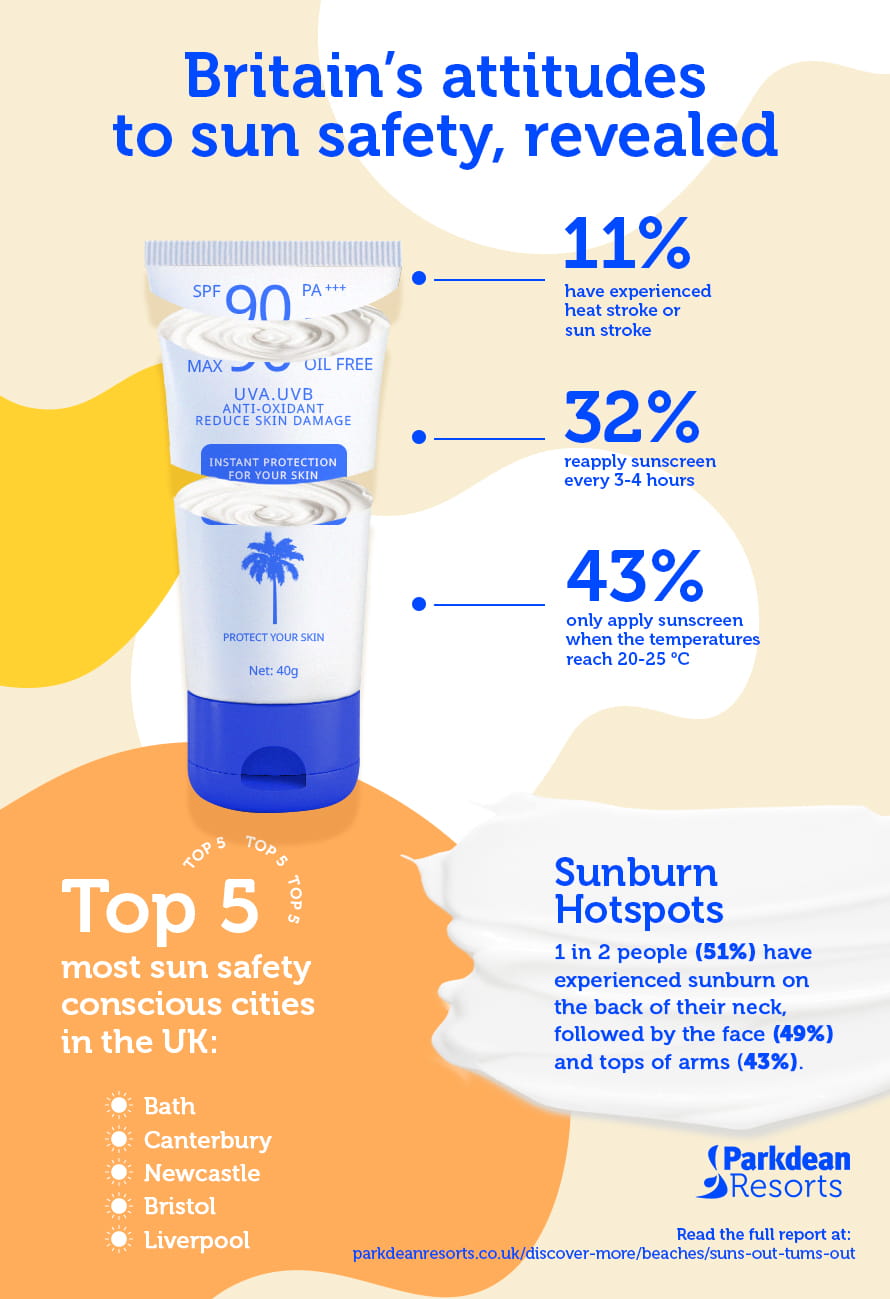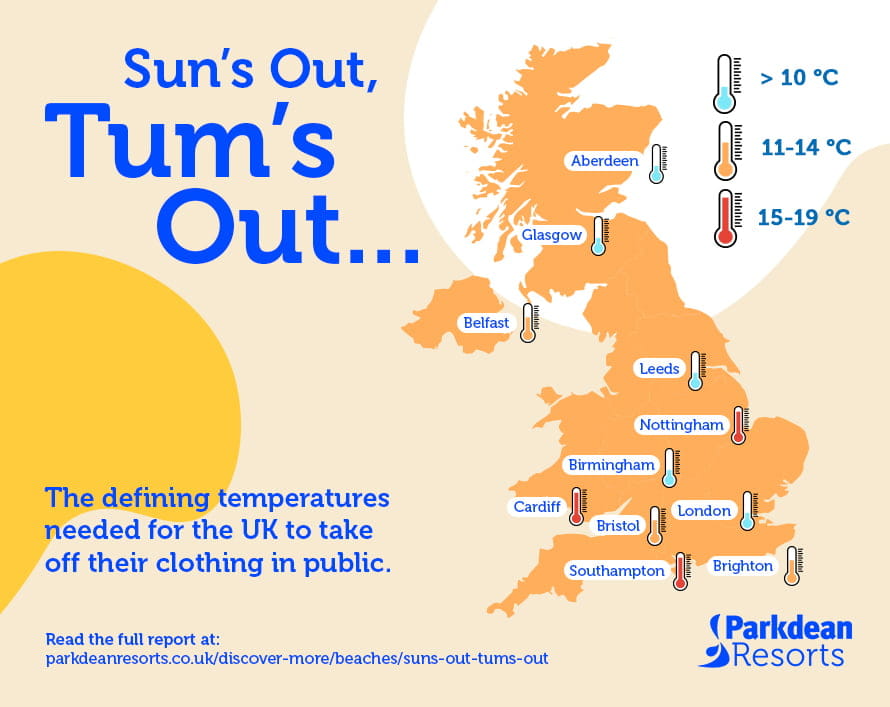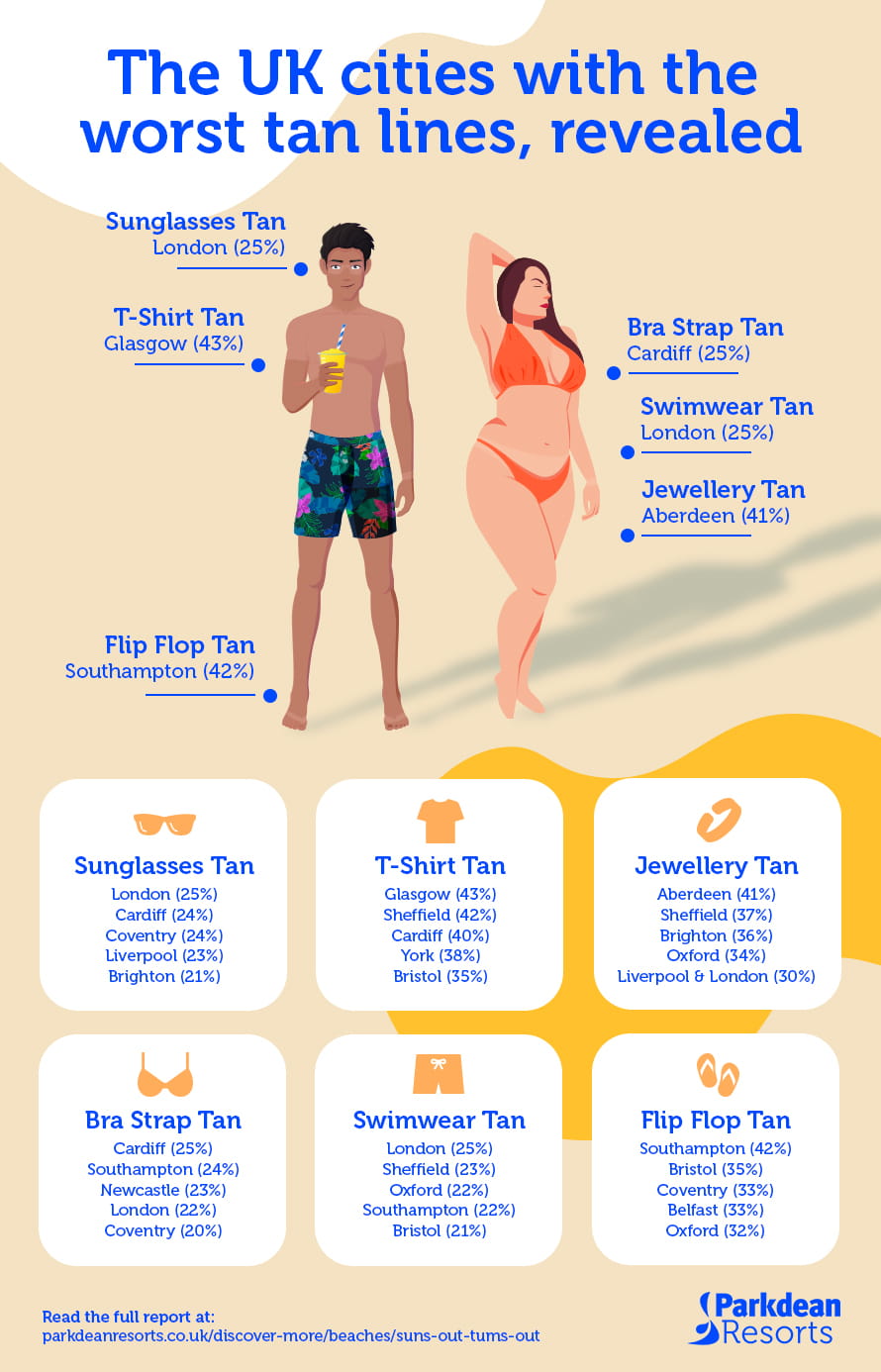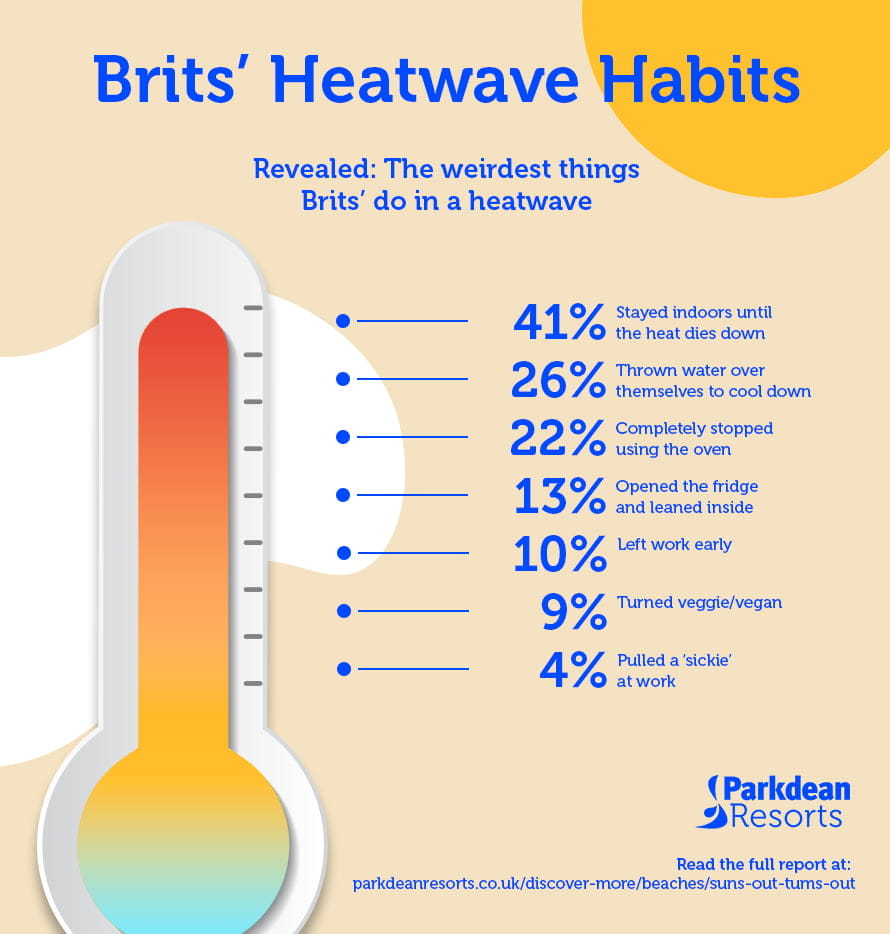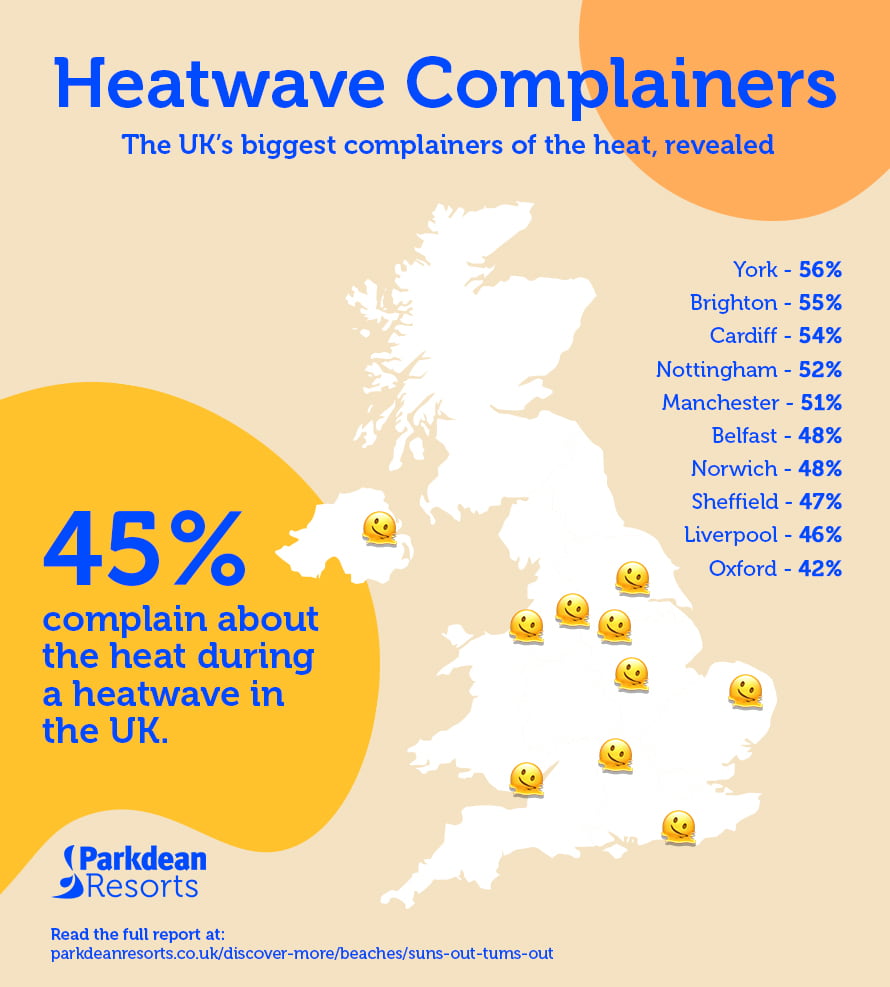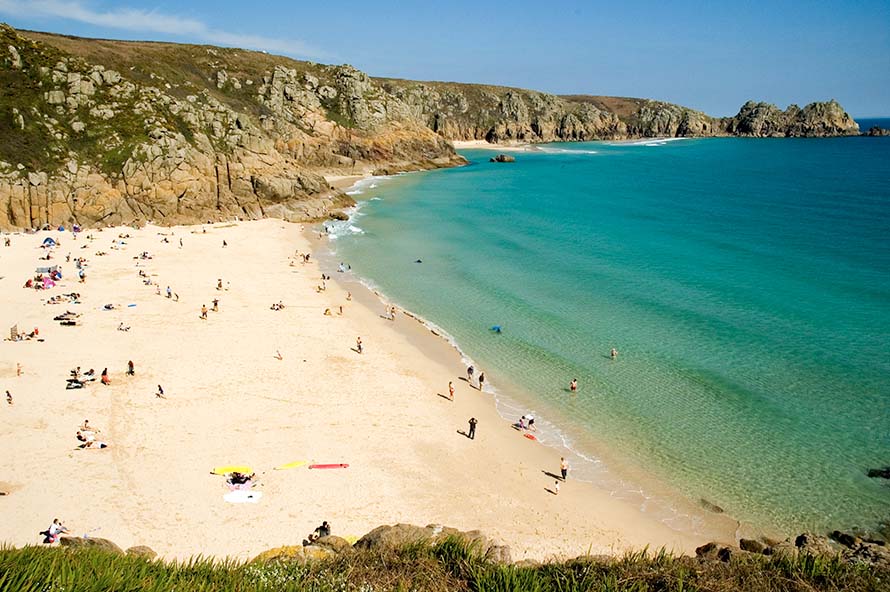By Parkdean Resorts on 22/06/2023
Summer 2023 is officially here! Cue road trips to UK beaches, ice creams with sprinkles and wincing as people take off their clothes in public places.
With around 159 days of rain on average a year, as a nation, we’re not very good at coping with any temperatures above 10 degrees - throw a heatwave into the mix and you have national chaos, varying swatches of sunburn and barbecues for breakfast.
We at Parkdean Resorts, conducted a study of 2,000 people in the UK to uncover the heatwave habits we’ve adopted as a nation. According to the data, Brits definitely live up to stereotypes with nearly half (45%) saying they complain about how hot it is when we do eventually get a heatwave here in the UK.
Our study also uncovers a national attitude problem to sun safety, with nearly a third (30%) saying they’ve experienced severe sunburn and another 30% admitting they’re regular sufferers of sunburn here in the UK, after not taking the proper precautions when basking in the sun.
According to the Met Office, summer 2023 will be even hotter this year, making it inevitable to see sightings of sunburnt skin and tribal tattoos - aren't you lucky? Here we reveal which cities are the most sun safety conscious, the most sun exposed, and the more lighthearted heatwave habits adopted by Brits in summertime.
The most sun safety conscious cities in the UK
According to the study, sunburn and other heat-related illnesses are rife in the UK, with 30% saying they’ve experienced severe sunburn and 11% even suffering heat stroke or sunstroke when temperatures soar. Another 30% say they experience sunburn ‘regularly’ from the UK sun after not properly applying sunscreen, or taking proper care when the heat hits.
Knowledge around sun safety appears to be a national problem with 42% of the UK saying they only apply sun cream when temperatures hit a scorching 20-25 degrees. Shockingly, the study shows that 14% only apply sunscreen once a day, and 12% never wear sunscreen at all, with 9% saying they only ever apply sunscreen when they can feel their skin burning.
Sunburn hotspots
The data shows which areas people suffer the most sunburn, 1 in 2 (51%) have experienced sun burn on the back of their neck, followed by the face (49%) and tops of arms (43%). Other problem areas from lack of sun safety include backs (29%), scalps (21%) tops of ears (20%) and tops of feet (20%) - ouch!
| Sunburn Area | Percentage |
| Back of neck | 51% |
| Face | 49% |
| Top of arms | 43% |
| Back | 29% |
| Scalp | 21% |
| Tops of ears | 20% |
| Tops of feet | 20% |
| Thighs | 13% |
| Knees | 12% |
| Calves | 11% |
Is sunburn bad?
Vitamin D is essential for good health and strong bones and it is recommended for people to get their daily vitamin D from taking supplements or dairy products, as there are health risks to the UV exposure when you're outside. However, most people get their vitamin D doing their normal daily activities outside and unprotected exposure to the sun’s harmful UV rays can cause sunburn which can lead to heat-related illnesses and premature skin ageing. Whilst the physical aspects of sunburn can be short-lived, any form of it can put you at risk of developing serious health problems such as skin cancer later on in life. According to research by skincancer.org, a person’s risk for melanoma doubles if they have had five or more sunburns.
The UK cities with the most sun safety
As part of the study, we ranked which regions of the UK are the most ‘sun safety savvy’ by looking at geographical searches for sun care products and people who had the least amount of sunburn based on our survey. We then ranked each location and scored them out of 100. Bath took the top spot as the city most conscious about sun safety scoring a whopping 80 out of 100, closely followed by Canterbury at 75 and Newcastle at 64.
| Count | City | Index score |
| 1 | Bath | 80/100 |
| 2 | Canterbury | 75/100 |
| 3 | Newcastle | 64/100 |
| 4 | Bristol | 62/100 |
| 5 | Liverpool | 57/100 |
The UK cities most exposed in the summer sun
It’s common knowledge that Brits love to get their kit off in hot weather. Millions of us take off items of clothes in public places, without sun protection, to try and cool off. Our study shows that a whopping 80% of people happily take off their clothes when there’s a heatwave here in the UK, but that’s not all, apparently, it’s only a habit we’re happy to flex on home turf!
According to the data, there are disparaging differences between heatwave habits in the UK compared to abroad, with 41% saying they never remove clothing in public when on holiday outside of the UK at higher temperatures.
The notion of ‘baring’ all in the UK summer sun is often associated with the scorched skin of men taking their tops off, but our study shows that 83% of women confess to taking off items of clothes in a heatwave, compared to 77% of men.
When looking at the cities that take off their clothes in public and which items are removed the most, many opt to go topless, barefoot and even remove trousers.
According to the study, 24% of Londoner’s strip down into just their underwear and take off their trousers, 42% of Aberdeen residents say they go barefoot and 20% of Bristolians say they go topless in a heatwave.
| Count | City | Clothing item | Percentage |
| 1 | Aberdeen | Shoes | 42% |
| 2 | London | Trousers | 24% |
| 3 | Bristol | T-shirts | 20% |
| 4 | Edinburgh | Trousers | 15% |
| 5 | Manchester | T-shirts | 15% |
On a city level, the study reveals that there are 7 major cities who strip off as early as April with Aberdeen, Birmingham, Glasgow, Leeds, Liverpool, London and Manchester saying the kit comes off at 10 degrees or higher - shield your eyes!
The 't-shirt tan' capitals of the UK
The ‘t-shirt tan’ is an unfortunate British cultural phenomenon, and according to our data, 32% of Brits have experienced one. Also known as a ‘farmer’s tan’, the ‘t-shirt tan’ can be characterised by a tan appearing only on the neck, face and lower arms, with the rest of the body seemingly unscathed from the sun.
According to the study, the biggest sufferers of T-shirt tans due to UK heat are Glasgow (43%), Sheffield (42%) and Cardiff (40%), and with 72% saying these miscellaneous tans have been ‘highly visible’, we were interested to know what other ‘strange’ tans are out there?
The study uncovered that 27% of Brits have had a flip-flop tan, with the same (27%) saying they’ve experienced a ‘jewellery tan’ and tanned through their necklaces, bracelets, rings and watches. 19% have had a sunglasses tan, 18% have suffered a bra strap tan and 18% have become a victim of a stubborn swimwear tan. Other unique tan lines reported are underwear tans (7%) and goggle tans (6%).
According to the NHS, there’s no safe or healthy way to get a tan and having one doesn’t protect you from the sun’s harmful effects including sunburn and other skin damage. So, whether you have a ‘t-shirt tan’ or a ‘flip-flop tan’, it’s important to know the potential risks associated with too much sun exposure.
Britain's heatwave habits
Our study reveals there’s a set pattern of behaviour Brits’ display when embarking on anything in a heatwave. When temperatures soar, so do the level of complainers, with a whopping 45% saying they regularly complain about how hot it is, with females (32%) more likely to complain than men.
When it comes to Brits’ worst heatwave habits, many (41%) become social recluses and stay indoors until the heat dies down, and 26% admit to throwing water over themselves to cool down mid-heatwave.
According to the study, our productivity and even likelihood of turning up to work takes a hit with 10% saying that during a heatwave they always leave work early and 4% have even called in sick.
British barbecue habits hit an all-time high in summer, but the study reveals people will grill come rain or shine, with 28% saying they happily barbecue in the rain, nearly half (49%) have cracked it out when cloudy, and 20% have grilled during thunder and lightning - yikes!
The UK's biggest complainers of the heat
Despite suffering rain and cold often, any sort of sudden uplift in temperatures sounds the alarm for British people to start complaining. We looked at which regions and cities are officially the UK’s biggest heat haters to determine where you’re most likely to hear “it’s too ‘ot” most likely accompanied by sunburn and questionable clothing choices.
According to recent Met Office reports Wales is set to experience the highest temperatures in the UK this summer. England generally has higher minimum and maximum temperatures than the rest of the UK, but Wales has higher minimum temperatures - it, therefore, came as a bit of a shock to see Wales residents are officially the biggest complainers of the heat, with over half (54%) saying they regularly say it’s too hot during a heatwave.
| Count | Region | Percentage |
| 1 | Wales | 54% |
| 2 | East Midlands | 54% |
| 3 | East Anglia | 52% |
| 4 | Yorkshire & The Humber | 51% |
| 5 | North West | 49% |
Looking at the UK cities who are the biggest complainers of the heat, York (56%), Brighton (55%) and Cardiff (54%) have all asked to speak to the sun’s manager.
How to stay safe at UK beaches this summer
With a great deal of Brits due to strip off this summer and many heading to UK beaches, it’s important to know how to properly protect yourself from the sun.
According to our study, 22% of UK adults say the only time they truly relax is on a staycation or foreign holiday. When looking at the data, 36% admit they need an escape from everyday life, and 30% say they find beach days more relaxing than a spa day.
It’s safe to say that more people will be looking to visit our gorgeous beaches this summer, so a spokesperson at Parkdean Resorts has shared their expert commentary on how to stay safe from the sun at UK beaches.
1. Avoid being in the sun from 11am - 3pm
According to the Met Office, the hottest time of day is between 11am and 3pm in summer, with the sun at its highest point at around noon. When at the beach, ensure you have a shaded area to escape the heat during this time - umbrellas and tents are essential for helping to avoid sunburn and UV damage while on an exposed beach.
2. The colour of the sand determines how cool you’ll be
Studies show that the darker the sand, the hotter the beach! Sand has a lower specific heat, meaning it needs very little energy from the sun to heat up. It can quickly become scorching and cause an injury known as ‘beach feet’. Whiter sand however, reflects more light and takes longer to heat up. With this in mind, you’re best visiting white sand beaches in hot weather. We ranked UK beaches based on how white their sand is and found the majority are typically found in Cornwall, with Kynance Cove in St Ives taking the top spot.
3. Drink plenty of water throughout the day
On hot days, people tend to lose water through sweat, meaning dehydration is common. Try to drink water every 20 minutes while out in the sun to limit the effects of the sun’s rays on your physical wellbeing. With days at the beach and a ‘cold one’ going hand in hand, it’s important to remember that other drinks such as alcohol or coffee (even the iced variety) are not a replacement for water.
4. Choose beaches with caves
Britain is home to around 1,500 beaches scattered across Ireland and the UK and comprises varying, luscious terrains. With open sand stretches and private, unspoilt beaches, some UK shorelines may lack shade. If taking pop up beach tents, parasols, or sun hats isn’t an option, try to visit a beach with a coastal cave. This way, you’ll be able to reserve a spot at the mouth of the cave, providing shade and coolness at even the busiest of times.
5. Wear sunglasses and a good sunscreen
Sunscreen and sunglasses are a must for a day at the beach, with sunscreen being something that should be applied daily and amped up during times like a day at the beach. Sunglasses protect your eyes from harmful UV rays, but they can also help to safeguard the sensitive skin area around the eyes from sun damage. Dermatologists recommend a good SPF of 30 or higher which should be applied every two hours - not sure how to apply sunscreen? Check our top tips below:
How to apply sunscreen
The NHS advises a no-frills approach to sunscreen and sun safety, and rightly so. If you plan on going out in the sun long enough to risk burning, sunscreen should be applied twice before you leave the house - 30 minutes before going out and just before you’re due to leave. Sunscreen should then be applied frequently and liberally every two hours. We’ve listed other important sun safety tips below:
- Make sure you get a good sunscreen by choosing a broad-spectrum SPF of 30, or higher. The ‘broad-spectrum’ means you’ll be protected from both UVB - the ones that cause sunburn, and UVA rays - these cause hyperpigmentation, skin cancer and premature signs of ageing
- Before applying sunscreen, make sure you give your bottle a good shake to help break up any clumping in the formula
- Apply sunscreen before you get dressed, then reapply to the areas which will be exposed to the sun, taking extra care around the face, tops of ears, the back of the neck and backs of hands - often these are missed
- When looking at the right amount to give maximum coverage to sun exposure - applying around two tablespoons of sunscreen will cover most adult bodies effectively. If you’re using spray, apply until an even sheen appears on the skin
- Ensure you reapply after being in water, embarking on a sweat-inducing activity, or after two hours. IT’s even recommended to apply sunscreen when indoors or on your work commute, as UVA rays can pass through windows and still cause damage
Ready for your UK summer beach adventure?
The UK coast is simply beautiful all year round, but what better way to enjoy all the UK has to offer than venturing to the seaside with the whole family? Whether you head to Camber Sands, Cayton Bay or Lizard Point, remember to pack plenty of sun cream and shade options to ensure you have an amazing and safe trip to the UK shore!
Methodology
- Parkdean Resorts commissioned a survey of 2,000 people in May 2023 on sun safety and heatwave habits.
- Parkdean Resorts looked at search volumes for sun lotion, sunscreen and after sun on a geographical level. They then added in the survey stats for sunburn into each region and created an index, ranking each location out of a score of 100

